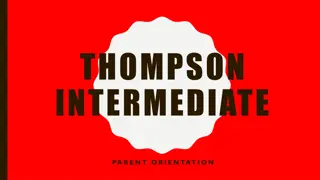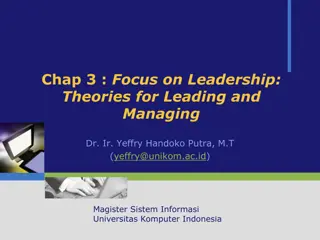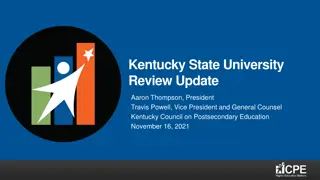
Nuclear Modernization Costs Over the Next 30 Years
Explore the significant investments required for nuclear modernization over the next three decades, covering expenses for various defense programs like Ohio Class SSBN Replacement, ICBM Follow-On, Long Range Strike Bomber, and more. The analysis also delves into strategic funding trends and cost-cutting strategies for programs like Ohio Replacement and ICBM Follow-On, highlighting potential savings and associated risks.
Download Presentation

Please find below an Image/Link to download the presentation.
The content on the website is provided AS IS for your information and personal use only. It may not be sold, licensed, or shared on other websites without obtaining consent from the author. If you encounter any issues during the download, it is possible that the publisher has removed the file from their server.
You are allowed to download the files provided on this website for personal or commercial use, subject to the condition that they are used lawfully. All files are the property of their respective owners.
The content on the website is provided AS IS for your information and personal use only. It may not be sold, licensed, or shared on other websites without obtaining consent from the author.
E N D
Presentation Transcript
DIME STORE DETERRENCE GETTING WHAT YOU PAY FOR Evan M. Thompson Research Associate, CBRN Octant Associates, LLC ethompson@octantassociates.com
COSTING NUCLEAR MODERNIZATION Investment Over Next 30 Years Ohio Class SSBN Replacement ($102 billion) ICBM Follow-On ($20-120 billion) Long Range Strike Bomber ($100 billion) Nuclear Air-Launched Cruise Missile (LRSO) ($20 billion) B61 Gravity Bomb Life Extension ($13 billion) O&M for next 30 years Current Triad, C&C, NNSA Activities ($727 billion) Total: ~$1.082 trillion
DoD Strategic Nuke Funding: Constant Dollars 80 Funding far below historical levels Only 5% of spending at peak bow wave 70 Total Funding (Billions of FY12$) 60 Investment Average (FYDP) = $5.7B 50 Recapitalization 40 New NAOC New ICBM 30 New cruise missile New SLBM? Investment New Bomber 20 New SSBN 10 Operations & Support 0 1994 1962 1970 1978 1986 2002 2010 2018 2026 2034 2042 2050 Fiscal Year 3 SSBN = ballistic missile submarine; NAOC = National Airborne Operations Center; SLBM = submarine-launched ballistic missile; New ICBM, New NAOC, and New SLBM are unfunded
OHIO REPLACEMENT How to Cut Costs? The Cost of Cutting Costs? Cut procurement to 8 submarines Estimated savings of $16 billion over 10 years (16% savings) Cut procurement to 10 submarines Estimated savings of $17 billion in 2030s (16% savings) Phase out oldest SSBNs early Estimated savings of $37 billion (36% savings) Smaller enemy target set Less range coverage Smaller fleet taxes individual boats Early phase out would strain fleet in the interim- generate increased risk
ICBM FOLLOW-ON How to Cut Costs? The Cost of Cutting Costs? Delay development by 5 years Estimated savings of $20.6 billion over 20 years (17% saving) Delay development and cut force size by 150 missiles Estimated savings of $31 billion over 20 years (26% saving) Refurbish existing ICBMS Estimated savings of $16 billion over 20 years (13% saving) Cut ICBM leg Estimated savings of $120 billion over 20 years (100% saving+O&M costs) Delays would put considerable strain on a platform that is already aging and approaching end of life Cutting force size would reduce the survivability of arsenal- fewer targets Weakens the most stable leg of triad Making cuts in the leanest, most affordable leg of the triad
LONG-RANGE STRIKE BOMBER How to Cut Costs? The Cost of Cutting Costs? Continued reliance on aging systems with limited capabilities Will not be able to penetrate sophisticated air defenses without a modern bomber force Delay in development would result in a delay in much-needed conventional capabilities as well- hampers power projection Delay may create higher costs in long- term Delay production for 10 years Estimated cost savings of $32 billion (32% saving)
LONG RANGE STANDOFF How to Cut Costs? The Cost of Cutting Costs? Cancel the LRSO development Loss of standoff capability as current ALCM ages out Estimated savings of $20 billion (100% savings) Sacrificing B-52 nuclear capability Necessitates greater risk for B-2 or LRS-B as vulnerability to sophisticated air defense increases
B61 LIFE EXTENSION How to Cut Costs? The Cost of Cutting Costs? Forced reliance on an aging delivery system Sacrificing the dual-capability of aircraft and flight crews and the F-35 dual capability Attrition of national lab capability as they are required to perform a smaller role in modernization Demonstrates an apparent lack of commitment to modernization that weakens assurance to allies Scale back B61 life extension by removing consolidation and avoid replacing non-essential non-nuclear components Estimated cost savings of $4 billion (20% saving)
TOTAL COSTS OF CUTTING NUCLEAR MODERNIZATION Sacrificing survivability and effectiveness of nuclear arsenal- a weakened deterrent and the appearance of it! Many suggestions for cost saving involve costly delays and smaller numbers Many suggestions for cost saving involve accepting deteriorating capabilities Losing comparative advantage against adversaries with growing arsenals and capabilities- nuclear and conventional! Attrition of skills and knowledge pool in warhead development and maintenance Marginal savings by making suggested cuts At its peak, nuclear modernization will only account for 5% of budget As long as we maintain an arsenal the costs will have to come eventually and delays will make it cost more Creates the perception of a lack of commitment to the nuclear mission, waning trust in the nuclear umbrella, and creates incentive for nuclear development in allies
WHERE TO CUT DEFENSE INSTEAD? DOD Infrastructure $800 billion in facilities worldwide- time to BRAC! Costs rising for maintaining and upgrading infrastructure Army facility capacity is 18% greater than needed Air Force facility capacity is 30% greater than needed MilPers Highest costs and rising Rising real healthcare costs Rising general healthcare costs Expanded coverage in procedures Shrinking premiums Higher than inflation pay raises






















